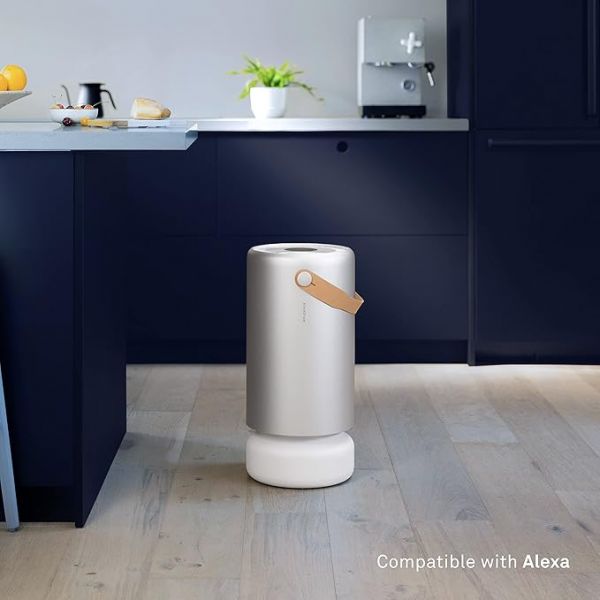Find the Perfect Smart TV for Your Home with Our Expert Buying Guide

-
- Determine Your Screen Size Requirements
- Room Dimensions
- Viewing Experience
- Understand Different Display Technologies
- LED-LCD Technology
- QLED Displays
- Compare Smart TV Operating Systems
- Roku OS
- tvOS
- Evaluate Sound Quality and Audio Features
- Check Connectivity Options and Smart Features
- Network Capabilities
- Smart Platform Functionality
- Set a Budget and Consider Long-term Value
- Evaluate Features Against Costs
- Consider Compatibility and Future-proofing
- Q&A:
- What should I consider regarding screen size when choosing a smart TV?
- How important is TV resolution, and what do 4K and 8K mean?
- What kind of smart features should I look for in a smart TV?
- Are there specific brands of smart TVs that are more reliable or offer better customer service?
- What are the advantages of having HDMI and USB ports on a smart TV?
- What features should I consider when selecting a smart TV for my home?
- Reviews
Prioritize screen resolution. Opt for 4K or higher for crisp visuals. LCD and OLED technologies offer diverse color accuracy and contrast levels.
Screen size matters. Measure viewing distance: 55 inches suits rooms around 7 feet away, while larger displays enhance immersion from greater distances.
Smart features enhance functionality. Built-in apps allow streaming without additional devices. Check compatibility with voice assistants for hands-free control.
Refresh rate affects motion clarity, especially during fast-paced scenes. Aim for at least 120Hz for an optimal viewing experience.
Audio quality should not be overlooked. Integrated speakers may require an external sound system for movie nights. Evaluate audio output options like Dolby Atmos support.
Connectivity options contribute to versatility. Ensure HDMI ports meet your needs, such as gaming consoles or soundbars, and verify Wi-Fi capabilities for smooth streaming.
Energy efficiency is advantageous. Look for energy ratings to save on electrical bills and promote sustainability.
Determine Your Screen Size Requirements
Calculate viewing distance to select optimal display dimensions. Recommended formula: divide distance in inches by 1.6 for 4K UHD resolution. For example, if seated 8 feet (96 inches) away, ideal screen size is approximately 60 inches.
Room Dimensions
Measure available wall space, ensuring width accommodates chosen model. Thin bezels increase screen size without additional wall real estate. Consider furniture arrangement and comfort to maintain valuable sightlines.
Viewing Experience
Account for intended use, such as movies, gaming, or sports. Larger screens enhance immersive experiences, while smaller displays remain suitable for casual viewing. Prioritize quality over sheer size-resolution impacts clarity and detail.
Maintenance of proper distance enhances visual comfort. Elevated positioning may require angling or tilting for optimal viewing angles. Evaluate seating height in relation to screen placement to avoid neck strain.
Future considerations include potential upgrades. Select a size allowing for flexibility in room configuration without requiring immediate replacement. Balancing aesthetics and practicality enhances long-term satisfaction with the purchase.
Understand Different Display Technologies
Consider OLED panels for deep blacks and vibrant colors. They offer superior contrast ratios compared to other technologies. These displays utilize organic compounds to emit light, resulting in breathtaking visuals.
LED-LCD Technology
LED-LCD screens use liquid crystal display technology enhanced with LED backlighting. This option is often more affordable than OLED. Look for models with local dimming features that improve contrast by dynamically adjusting backlight zones.
QLED Displays
QLED, developed by Samsung, employs quantum dots to enhance brightness and color accuracy. These screens perform exceptionally well in bright rooms. Research options with high peak brightness for superior HDR performance.
Ultimately, assess room lighting and viewing habits to determine the most suitable display technology. Each type has unique attributes catering to diverse preferences.
Compare Smart TV Operating Systems
Android TV offers extensive app support and easy integration with Google services. It features Google Assistant for voice commands and allows casting from Android devices effortlessly.
Roku OS
Roku provides a user-friendly interface with access to numerous streaming channels. Its search function covers various platforms, allowing for comparison of content across services. Regular updates ensure new features and channels are added frequently.
tvOS
tvOS, exclusive to Apple devices, integrates seamlessly with iOS and macOS, allowing synchronization of apps and content. Apple TV offers features like AirPlay for streaming from Apple devices and a refined interface with access to original content from Apple TV+.
Choosing an operating system significantly impacts user experience, app availability, and integration capabilities. Consider compatibility with existing devices when making a selection.
Evaluate Sound Quality and Audio Features
Prioritize models with built-in surround sound systems. These enhance audio immersion, providing a cinema-like experience at home.
Check for Dolby Atmos support; this technology creates an immersive audio environment by allowing sound to move in a three-dimensional space.
Consider sound output measured in watts. A minimum of 20 watts is recommended for adequate volume and clarity.
Look for TVs with multiple audio modes. Options such as Movie, Music, and Standard can optimize sound according to content type.
Investigate whether the television includes soundbars or compatibility with external audio systems for upgraded performance.
Read reviews focusing on sound quality assessments. User feedback can reveal real-world performance, particularly in bass response and clarity.
- Sound stabilization features are beneficial for consistent audio quality regardless of volume levels.
- Equalizer settings allow customization of sound output based on personal preferences and room acoustics.
- Test audio during in-store demonstrations or check online videos to evaluate speaker effectiveness.
Assess connectivity options; Bluetooth or HDMI ARC capabilities can simplify pairing with external audio devices.
Keep an eye out for brands known for superior sound engineering. Researching brand reputation can guide selections.
Check Connectivity Options and Smart Features
Prioritize HDMI ports. Minimum of three inputs allows connection of multiple devices, such as gaming consoles, soundbars, and Blu-ray players. Look for HDMI 2.1 specifications if planning to game at 4K with high refresh rates.
Network Capabilities
Ensure built-in Wi-Fi supports dual-band connectivity for stable streaming. Ethernet ports provide additional reliability, particularly for 4K content. If possible, consider models with support for Wi-Fi 6, which enhances speed and reduces latency.
Smart Platform Functionality
Evaluate available applications and user interface. Major ecosystems like Android TV, Roku, or Tizen offer extensive app libraries and voice assistant integration. Check for timely updates, as these enhance performance and security.
Set a Budget and Consider Long-term Value
Establish a financial framework before researching options. Allocate no less than $500 for quality displays, while premium selections may require $1,000 or more. Look for warranties extending beyond the usual year to guard against future repairs. Factor in not just initial costs but also energy consumption; models with energy-saving features can reduce your bills over time.
Evaluate Features Against Costs
Each feature adds to overall pricing. High refresh rates, HDR support, and smart capabilities enhance viewing experiences but increase expenses. Prioritize what matters: if streaming services dominate usage, prioritize processor speed and app compatibility over visual frills that may be infrequently used.
Consider Compatibility and Future-proofing
Ensure chosen device supports current and upcoming technology standards like HDMI 2.1 and 8K resolution. Spending a bit more now can delay the need for another upgrade in the near future. Research potential software updates that can extend device lifespan beyond hardware limitations.
Q&A:
What should I consider regarding screen size when choosing a smart TV?
When selecting the screen size for your smart TV, the distance between the TV and the seating area is key. Generally, a larger screen is better for bigger rooms, while smaller screens can fit well in compact spaces. A good rule of thumb is to sit at a distance that is 1.5 to 2.5 times the diagonal size of the screen, allowing for comfortable viewing without straining your eyes. Additionally, consider the height at which the TV will be mounted or placed, ensuring that it's at eye level when seated.
How important is TV resolution, and what do 4K and 8K mean?
TV resolution significantly affects picture quality. Standard HD resolution is 1080p, while 4K offers four times that resolution, providing crisper images and more detail, especially on larger screens. 8K, on the other hand, delivers even higher clarity, perfect for extremely large displays, but content in 8K is still limited. For most viewers, a 4K resolution is a solid choice, offering excellent quality that enhances the viewing experience without requiring 8K's advanced technology and content availability.
What kind of smart features should I look for in a smart TV?
Look for smart TVs that support popular streaming services like Netflix, Hulu, and Amazon Prime. Check if the TV has a user-friendly interface that makes it easy to browse content. Voice control features can also enhance convenience. Additionally, compatibility with smart home devices can be beneficial for integration into your home automation system. Some models even have built-in assistants like Alexa or Google Assistant, making it easier to control the TV without a remote.
Are there specific brands of smart TVs that are more reliable or offer better customer service?
Brands such as Samsung, LG, and Sony are often recognized for their quality and customer support. Each brand has different models that cater to various needs. Samsung's QLED technology offers vibrant colors and brightness, while LG's OLED displays are noted for their deep blacks and rich contrast. It's advisable to check customer reviews and warranty options before making a decision, as these factors can reflect not only product quality but also the level of support you can expect.
What are the advantages of having HDMI and USB ports on a smart TV?
Having multiple HDMI ports on a smart TV allows you to connect several devices, such as gaming consoles, Blu-ray players, and sound systems, without needing to swap cables frequently. USB ports can be used for connecting external storage devices, which means you can easily access and view your personal media files. Some TVs also offer recording capabilities through USB, allowing you to save shows directly from the TV for later viewing. When choosing a TV, consider the number of ports available based on your anticipated use.
What features should I consider when selecting a smart TV for my home?
When choosing a smart TV, there are several features to consider. First, think about the screen size that fits your space; measure the distance from your seating area to ensure a comfortable viewing experience. Resolution is also key; most modern TVs come in Full HD (1080p) or 4K Ultra HD, with 4K providing a sharper image. Pay attention to smart features; different brands offer various streaming services and apps. It's worth checking the operating system, such as Android TV or Roku, as this will impact usability. Connectivity options are important too; ensure there are enough HDMI ports for your devices and consider if the TV supports Wi-Fi and Bluetooth for easy pairing. Lastly, look for reviews on picture quality and sound, as these can significantly influence your viewing experience.
Reviews
Alexander Smith
I recently purchased "How to Choose the Right Smart TV for Your Home," and I couldn't be happier with my decision. The guide is straightforward and informative, making the whole process of selecting a smart TV much simpler. It covers all the key features to consider, from screen size to resolution and smart features. I appreciated the section on compatibility with streaming services, as I'm a big fan of Netflix and Hulu. The explanations are clear, and the comparisons helped me understand what different brands offer. There's also practical advice on setting up the TV, which was great for a tech novice like me. The writing style is engaging, and it doesn't overwhelm you with technical jargon. Each section flows well and presents information concisely. By the end of the guide, I felt confident in my ability to choose the right smart TV for my needs. I recommend this guide to anyone shopping for a new TV.
Ava
I recently purchased "How to Choose the Right Smart TV for Your Home" and I couldn't be happier with my decision. The guide is straightforward and packed with practical advice. It really helped me identify what features I needed for my living space. I appreciated the way it breaks down different types of smart TVs and their specifications. The section on the various streaming platforms was particularly useful, as it helped me choose a TV that supports all my favorite apps. I also found the tips on screen size and resolution to be helpful, making it easier to visualize how the TV would fit into my room. The language is easy to understand, which is great for someone like me who doesn't have a technical background. I felt supported throughout my buying decision without being overwhelmed by jargon. If you're looking to purchase a smart TV, this guide is a must-read. It will save you time and help you avoid common pitfalls. Highly recommended!
SilverFox
I recently purchased "How to Choose the Right Smart TV for Your Home" and found it incredibly helpful. As someone who isn't tech-savvy, I appreciated the straightforward explanations of features and specifications. The book covers various brands and models, which made it easier for me to compare options based on my needs and budget. I particularly liked the section on connectivity options, as I wanted a TV that could seamlessly connect to my devices. The tips on picture quality were enlightening; I've never considered factors like HDR or refresh rates before. The writing style is engaging and easy to follow, making it suitable for both novices and those with some experience. It didn't overwhelm me with jargon, which I found refreshing. After following the advice in the book, I feel confident in my decision to invest in a smart TV that fits perfectly into my living space. I would recommend this guide to anyone looking to buy a TV without the headache of sifting through endless online reviews.
Sophia Brown
I recently purchased "How to Choose the Right Smart TV for Your Home," and I couldn't be happier with my decision. The book is straightforward and easy to read, making it perfect for anyone, regardless of their tech knowledge. It covers all the important features to consider, like screen size, resolution, smart features, and sound quality. I particularly appreciated the sections comparing different brands and models, which helped me narrow down my options. The tips on setting up the TV and optimizing picture settings were very useful. I found the recommendations tailored to varying budgets especially helpful. After reading, I felt confident in my choice and ended up with a TV that fits my needs perfectly. If you're looking to buy a smart TV or just want to learn more about what's available, this book is a great resource! Highly recommended!
Mason
I recently purchased "How to Choose the Right Smart TV for Your Home," and I found it to be incredibly helpful. The guide covers all the necessary features and specs to consider, making the selection process a lot easier. I appreciated the straightforward explanations of OLED vs. LED, resolution options, and smart features. The section on user interface was particularly useful; it helped me understand how to choose a TV that fits my streaming habits. The comparisons between different brands were clear and unbiased, which I found refreshing. I was also glad to see recommendations for various budgets. One downside was that some sections could have gone into more detail, especially regarding connectivity options. However, the overall content was engaging and informative. After following the advice, I feel confident in my choice of TV, and I'm loving the picture quality and features. If you're in the market for a new smart TV, I highly recommend checking out this guide!
Maria Johnson
I recently purchased "How to Choose the Right Smart TV for Your Home," and I must say it's been incredibly helpful. The guide is clear and straightforward, making it easy to understand the features that truly matter. I appreciated the sections on screen size, resolution, and smart capabilities, which helped me narrow down my choices without feeling overwhelmed. The comparisons between different brands were particularly useful, as I was unsure about which options offered the best value for money. I found the tips on connectivity and compatibility with other devices to be quite practical. It also provided insights into various operating systems, making my decision more informed. What stood out the most was the emphasis on personal preferences and how to align them with features. I feel more confident in my choice now, and I'm excited about setting up my new TV. If you're looking for guidance on this topic, I highly recommend giving this book a try!








